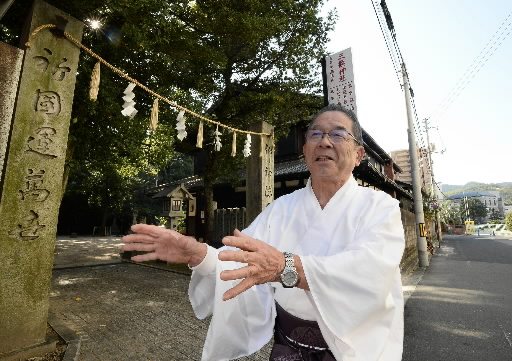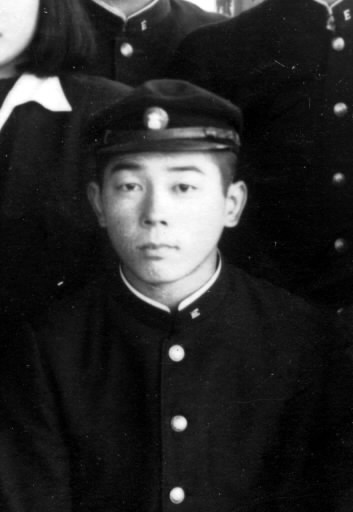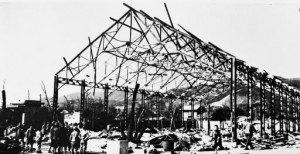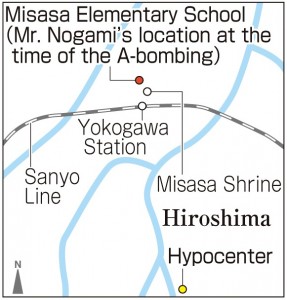Mitsuaki Nogami, 79, Nishi Ward, Hiroshima
Nov. 12, 2013
Soaked up to his waist inside air-raid shelter; No thought of danger of water
by Sakiko Masuda, Staff Writer
Mitsuaki Nogami, 79, was at Misasa National School (now Misasa Elementary School in Hiroshima’s Nishi Ward), 1.9 km from the hypocenter, at the time of the atomic bombing. He was a sixth grader at the school. After returning home, he went into an air-raid shelter, where he remained until the flames had died down. Before long, rain began to fall. Rainwater came into the shelter, and Mr. Nogami was soaked up to his waist. At the time, he never imagined that there was radioactive material in the water.
That day, as he was about to go out into the schoolyard for the morning assembly, his teacher asked him to take some chairs to the auditorium. After he was finished, he returned to his classroom and was just about to head out to the schoolyard when there was a loud boom and he passed out. When he came to, he found that he had been blown 7 or 8 meters into the hallway. He had some scratches on his left arm but no serious injuries.
His house was at Misasa Shrine, next to the school. He dashed home and found his father had just crawled out from under the collapsed shrine office building, where he had been trapped. He was cut in about 30 places.
Mr. Nogami and his father were going to flee, but they were surrounded by flames on all sides and couldn’t get away. To the west, the trees at the school were in flames, and the building to the north had caught fire. Oxen that had been used in the demolition of buildings came racing toward them from the east. They decided to flee to the south, but people coming from that direction stopped them, saying they would not be able to get through.
So they had no choice but to dive into the air-raid shelter that had been dug on the grounds of the shrine. Some people from the neighborhood had already gone into the shelter. As the fiery winds approached, Mr. Nogami and his father decided to get into a different shelter. They urged the neighbors to do so also, but they declined, saying they wanted to die beside the god of the shrine. Of the four people who remained there, three died in the shelter.
Mr. Nogami and his father stayed in the other shelter until evening, sitting in rain water up to their waists, and waited for the flames to subside. When they finally emerged, they set off on foot for the village of Kawauchi (now part of Asa Minami Ward), where Mr. Nogami’s mother, younger brother and three younger sisters had moved to escape air raids. They arrived around 9 p.m. and stayed through the end of the war and into mid-September.
After the war Mr. Nogami became a teacher, and starting in 1959 he taught at elementary schools for nearly 30 years. After the death of his father in 1988, he took over as chief priest at Misasa Shrine. He married in 1964 and has seven grandchildren. He began recounting his A-bombing experiences after he retired from teaching. He talks to students at Misasa Elementary School and students on field trips, conveying to them the horrors of the atomic bombing.
Six years ago he was diagnosed with bladder cancer. He thinks it may have been caused by the rainwater he was immersed in just after the A-bombing. “The effects of the atomic bombing last for years,” he said. “Nuclear weapons absolutely must not be permitted.”
Teenagers’ Impressions
Stretch my imagination
As he talked to us about his A-bombing experiences, Mr. Nogami repeatedly asked, “If you were in that situation, how would you feel?” Because I did not experience the A-bombing, I really don’t know how scary it was. But I want to stretch my imagination and think seriously about what I should do to eliminate nuclear weapons from the world. (Minami Tanioka, 14 years old)
Shared desire to eliminate nuclear weapons
Mr. Nogami said he would like us to reach out to all of the nuclear nations and work to eliminate nuclear weapons from the world. I believe that behind this is the shared desire of all survivors that the calamity of an atomic bombing never occurs again anywhere in the world. In order to bring about a world without nuclear weapons, I want to hear as many survivors’ stories as I can, and tell the people around me about what happened on August 6. (Ryo Kamiyasu, 17 years old)
Hiroshima Insight
Misasa National School
Hit by blast during morning assembly
Misasa National School (now Misasa Elementary School) was located in Misasa Hon-machi (now part of Nishi Ward), about 1.9 km north of the hypocenter. The school building and the auditorium were destroyed by fire in the A-bombing.
According to the Record of the Hiroshima Atomic Bombing published by the city, the school was large, with a student body of more than 2,000, but at the time of the atomic bombing, most of the students had relocated outside the city. On the morning of August 6, only about 90 students were at the school. They were in the schoolyard for the morning assembly and were blown about by the blast. They cried in pain with their clothing burned to tatters and the skin on their faces, arms and legs peeling off. Thirty students and three teachers were killed instantly.
Students who had gone to the vicinity of Koami-cho (now part of Naka Ward) to demolish buildings for fire breaks also died. According to a special exhibition on mobilized students mounted by the Peace Memorial Museum in 2004, 61 students at Misasa National School were killed in the atomic bombing.
Until temporary school buildings were erected in December 1945, classes were held outdoors.
Staff Writer’s Notebook
On August 9 Mr. Nogami returned briefly to his home at Misasa Shrine (Nishi Ward) from the village of Kawauchi (now part of Asa Minami Ward), to which he had fled.
He said he will never forget what he saw there. The shrine had been destroyed by fire, and the entire area was burned out. An elderly couple from the neighborhood and their grandchild had died in a shelter that had been dug on the grounds of the shrine.
Mr. Nogami also saw bodies being brought to the neighboring Misasa National School (now Misasa Elementary School). He can still recall the stench of the burned-out ruins.
All of the members of his family escaped injury, but many students at Misasa National School, which Mr. Nogami attended, died. After the war he had recurring dreams of losing his family and friends and being left alone.
Mr. Nogami said he will continue to tell children of his experiences in the hope that no one will ever again have to experience the horrors of an atomic bombing or war. (Sakiko Masuda)
(Originally published on November 12, 2013)











